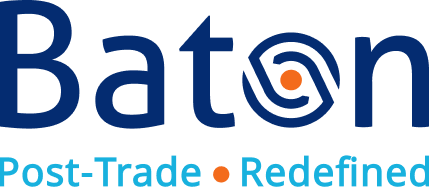Jerome Kemp, President at Baton Systems, explains how the use of distributed ledger technology (DLT) can enhance post-trade processes. By embracing this technology, market participants can achieve dramatically higher levels of efficiency and transparency, reducing settlement risk and optimising the way in which firms manage funding and liquidity.
When evaluating the technologies used to redefine efficiency, transparency, and risk management in the post-trade space, the term ‘blockchain’ has become a catch-all, conflating all new network technology that leverages some form of immediate and immutable data syndication.
A blockchain is a permissioned, private, or public network operating in the absence of a central authority. Data, whose immutability is determined by an algorithmically generated electronic signature, is distributed instantaneously and simultaneously to all participating nodes on the network.
Initially, financial markets were excited by the possibilities that blockchain could offer. For a number of reasons, blockchain as the basis of a scalable framework in the post-trade space is challenged. Blockchain in this context has been associated with inconclusive initiatives causing regulators, legislators, and financial institutions themselves to take a very restrictive view of this technology. While Blockchain heralded a radical step forward for markets, this is coming to a close and the industry finds itself in a period of reassessment.
Differentiating Blockchain from Distributed Ledgers
‘Blockchain’, however, is just one expression of a broader generation of emergent network technologies, namely distributed ledgers. It is only recently that differentiation between blockchain and distributed ledger technology has started to become more pronounced in discussions about the technological solutions driving change in the post-trade space.
Whereas blockchain technology relies upon the generation of ‘proof of work’ by means of increasingly complex algorithms, a distributed ledger can achieve simultaneity, instantaneity, and immutability of information shared across a network in a manner that inter-operates with existing infrastructures while allowing for a dramatic improvement in the overall efficiency, transparency, speed, and accuracy of post-trade processes.
Moreover, in addition to the shared visibility of permissioned data, distributed ledger technology provides the framework for shared workflows, enabling permissioned network participants to settle trades on demand using data that has been mutually agreed upon and notarised as definitively representing the trades, exposures, and obligations amongst them.
“It is only recently that differentiation between blockchain and distributed ledger technology has started to become more pronounced in discussions about the technological solutions driving change in the post-trade space”
How Baton is using DLT
At Baton Systems we are in production today with this very solution for FX settlements.
Baton’s Core-FX™ platform addresses the entire post-trade value chain, from trade ingestion and affirmation to bilateral netting in a currency or currency pairs, to the on-demand riskless settlement of bilateral obligations with settlement finality. This compares with the market’s legacy payment versus payment (PvP) settlement provider CLS, which addresses roughly 40% of settlements on an average day across 18 eligible currencies and around 78 direct platform participants. This solution requires the immobilisation of significant funding and liquidity resources over extended time intervals and fails to address the growing volumes and therefore settlement, funding, and liquidity challenges that typically characterise rapid growth in the trading of ineligible currencies.
The settlement of ineligible currencies is not a small problem: over $2 trillion dollars of ‘risky’ settlement is left on any given day. Baton harnesses the vast amounts of data required to empower its clients to acknowledge, validate, net, and coordinate the components of their settlement obligations in real-time, Baton provides for the overall orchestration of a riskless PvP settlement process with finality in virtually any currency not subject to restrictions. New currencies can be added quickly, empowering market participants to think about managing settlement risk in a very different way.
“Baton’s Core-FX™ platform addresses the entire post-trade value chain, from trade ingestion and affirmation to bilateral netting in a currency or currency pairs, to the on-demand riskless settlement of bilateral obligations with settlement finality”
What does this mean for the industry today?
The implications of using DLT and workflows via Baton to settle FX are exceptionally meaningful in today’s environment. Extinguishing a settlement obligation with a counterparty on a riskless basis with finality in a five-minute window rather than over a 24-hour cycle should have broad appeal. Traders can recycle trading lines to generate more turnover and revenue with existing clients. In light of the flexibility that Baton’s distributed ledger based settlement protocol offers to its clients, new trading opportunities with counterparties could emerge given the ability to settle exposures on demand: risk managers are in much better control of the exposures that they typically have been forced to carry overnight due to batch processes and the lack of availability of real-time gross settlement (RTGS) systems.
From a funding and liquidity perspective, the ability to sequence settlements as a function of rolling funding and liquidity cycles in markets and currencies across the global ‘day’ is a clear advantage. And, from a specific funding perspective, a firm may be better served by settling smaller shapes over the course of a day and recycling these funds more dynamically than by immobilising a much larger amount of funds over a protracted settlement horizon.
“The implications of using DLT and workflows via Baton to settle FX are exceptionally meaningful in today’s environment”
And tomorrow?
A major change is underway in the way markets operate, from the assets traded to the way in which risk, funding, and liquidity are managed and regulated. It is clear that this is a focal point for regulators and legislators around the world today, even though many are sceptical (or even afraid) of this new generation of technology. Initiatives, studies, and experiments are ongoing, with central banks along with numerous buy-side and sell-side institutions actively involved. In short, the train has left the station…it may look more like a steam engine today given the novelty, but this will rapidly become a Shinkansen. Markets have demonstrated time and time again that the adoption of new technology can occur very quickly, empowering the visionaries and leaving the resisters in the dust.
The post-trade space in the next five to 10 years will be dominated by distributed ledger-based protocols which will have largely replaced the legacy, batch-based systems which dominate the landscape today. In the same way that electronic trading took the world by storm three decades ago, the introduction of this new technology and its continuing development will revolutionise speed, accuracy, transparency, and efficiency not only in settlements but also in the way in which firms manage their broader payment and collateralisation obligations.
The adoption and integration of these technologies will have an unprecedented impact on the overall quantum of uncollateralised exposure in any given market, ultimately providing for safer and more robust market infrastructures across the entire user spectrum.
“The post-trade space in the next five to 10 years will be dominated by distributed ledger-based protocols which will have largely replaced the legacy, batch-based systems which dominate the landscape today”
I hope that you found this blog useful in explaining how DLT can improve and enhance post-trade processes. To learn more about Core-FX, please don’t hesitate to contact me at [email protected]

